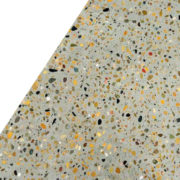Tile Ghosting Causes
Tile Ghosting
Causes
Tile marks or tile ghosting are caused and affected by moisture intrusion. These lines can (1) come from within or below the slab, or they can develop (2) from processes or treatments applied on the VCT above the slab.
(1) Moisture vapor transmission through a concrete slab is caused by the need for the moisture to reach equilibrium, which is achieved when all parts of the system have the same amount of moisture content. When the ground below the slab is very wet and the concrete above it is not, the water will travel from the ground up into the slab because the slab is drier. Then the water will again seek a drier space. Heating and cooling systems control the temperature and humidity of the air in the rooms, and as moisture is removed from room air, the moisture in the slab will naturally move up through the tile seams toward the dry air. The moisture in question may be from within the slab itself as the normal amount of water needed to place the concrete. It can also come from a source underneath the slab, such as a high water table, a leaky pipe, or a sprinkler system.
Movement of salt-laden water up through the slab is the same phenomenon that causes traditional efflorescence issues with concrete and masonry. Moisture migrates up according to the laws of physics, always seeking equilibrium, while dissolving and carrying along free lime, calcium hydroxide and salts that have not reacted during the curing of the slab. When the salted water evaporates at the slab surface, it leaves the salts behind, which form an ever-widening line. As long as there is a continuous supply of water to the concrete, there will be moisture transmission, and the tile marks will continue to develop.
(2) Topical processes or treatments are the other major source of tile marks. The quality of the tile installation itself is a major factor, as is the janitorial treatment of the area. Are all of the tiles tight against one another or is there visible space? Were multiple coats of floor finish applied prior to opening? Did crews prevent janitorial liquids from puddling on the floor for extended time periods? All of these factors help determine the amount of lines and whitening that occurs during years of routine janitorial maintenance procedures.
Washing, waxing, stripping and re-waxing are processes that can drive a steady stream of water directly into the concrete surface. Puddles of chemicals and dirty or gray water are allowed to dwell on the floor and seep down through the seams into the concrete slab. Gray water with its residual chemicals soon becomes trapped underneath the tile by subsequent applications of wax and high-speed burnishing. When gray water manages to escape through the tiles’ gaps and seams, it will leave behind the insoluble salts at the surface of the slab: our old nemesis, efflorescence.
As the salts are dissolved from within the slab and moved up to the surface, the body of the concrete loses its free salts and becomes even more porous as a result, allowing yet more gray water to penetrate. This repeated cycle of soaking, dissolving salts, movement of salts to the surface, evaporation of water, and deposition of salty residue at and near the surface helps creates the tile mark problem.



